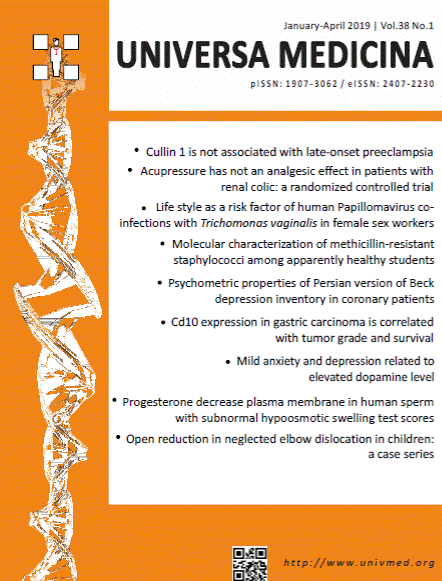Cullin 1 is not associated with late-onset preeclampsia
Main Article Content
Abstract
Late-onset preeclampsia (PE) is preeclampsia occurring after 34 weeks of gestational age or later. Cullin 1 (CUL1), a proangiogenic protein, is expressed in the placenta, where an imbalance between proangiogenic and antiangiogenic proteins during gestation can cause disturbance of trophoblast invasion. This defect results in vascular ischemia that may produce preeclampsia. The objective of this study was to determine the correlation between CUL1 as proangiogenic factor and late-onset preeclampsia.
Methods
This study was of analytical observational cross-sectional design and involved 44 preeclampsia patients with ³34 weeks of gestational age (late-onset PE). The CUL1 level in the subjects’ sera, taken before they gave birth, and in homogenates of their placenta, obtained per vaginam or by cesarean section, were examined by the ELISA technique. Statistical analysis was performed with the Spearman correlation test with significant p value of <0.05.
Results
Median maternal age was 31 years and median gestational age was 37 weeks. Median serum CUL1 was 41.78 pg/mL and median placental homogenate CUL1 was 32.24 pg per milligram of total placental tissue protein. There was no significant correlation between serum CUL1 level and late-onset preeclampsia (r=-0.281; p=0.065). There was also no significant correlation between placental CUL1 level and late-onset preeclampsia (r=-0.166; p=0.281).
Conclusion
Serum CUL1 and placental CUL1 were not correlated with late-onset preeclampsia. However, this study indicated that low serum CUL1 tends to prolong gestational age in preeclampsia.
Article Details
Issue
Section
The journal allows the authors to hold the copyright without restrictions and allow the authors to retain publishing rights without restrictions.
How to Cite
References
Woelkers D, Barton J, von Dadelszen P, et al. [71-OR]: the revised 2013 ACOG definitions of hypertensive disorders of pregnancy significantly increase the diagnostic prevalence of preeclampsia. Pregnancy Hypertens 2015;5:38. doi: 10.1016/j.preghy.2014.10.075.
Eiland E, Nzerue C, Faulkner M. Preeclampsia 2012. J Pregnancy 2012, Article ID 586578, 7 pages. doi: 10.1155/2012/586578 2012.
Valensise H, Vasapollo B, Gagliardi G, et al. Early and late preeclampsia: two different maternal hemodynamic states in the latent phase of the disease. Hypertension 2008;52:873-80. doi: 10.1161/HYPERTENSIONAHA.108.117358.
Ness RB, Sibai BM. Shared and disparate components of the pathophysiologies of fetal growth restriction and preeclampsia. Am J Obstet Gynecol 2006;195:40-9.
Sibai B, Dekker G, Kupferminc M. Pre-eclampsia. Lancet 2005;365:785-99.
Tomimatsu T, Mimura K, Endo M, et al. Pathophysiology of preeclampsia: an angiogenic imbalance and long-lasting systemic vascular dysfunction. Hypertens Res 2017;40:305-10. doi: 10.1038/hr.2016.152.
Vaswani K, Hum MWC, Chan HW, et al. The effect of gestational age on angiogenic gene expression in the rat placenta. PLoS One 2013;8: e83762. doi: 10.1371/journal.pone.0083762.
Romero R, Chaiworapongsa T. Preeclampsia: a link between trophoblast dysregulation and an antiangiogenic state. J Clin Invest 2013;123:2775-7. doi: 10.1172/JCI70431.
Powe CE, Levine RJ, Karumanchi SA. Preeclampsia, a disease of the maternal endothelium: the role of antiangiogenic factors and implications for later cardiovascular disease. Circulation 2011;123:2856-69. doi: 10.1161/CIRCULATIONAHA.109.853127.
Li W, D Liu D, Chang W, et al. Role of IGF2BP3 in trophoblast cell invasion and migration. Cell Death Dis 2014;5:e1025. doi: 10.1038/cddis.2013. 545.
Zhu JY, Pang ZJ, Yu YH. Regulation of trophoblast invasion: the role of matrix metalloproteinases. Rev Obstet Gynecol 2012;5: e137-43. doi: 10.3909/riog0196.
Zhang Q, Chen Q, Lu X, et al. CUL1 promotes trophoblast cell invasion at the maternal–fetal interface. Cell Death Dis 2013;4:e502. doi: 10.1038/cddis.2013.1.
Zhang Q, Yu S, Huang X, et al. New insights into the function of Cullin 3 in trophoblast invasion and migration. Reproduction 2015;150:139-49. doi: 10.1530/REP-15-0126.
Zhuang T, Fu J, Zhang Q, et al. CUL4A is expressed in human placenta and involved in trophoblast cell invasion. Int J Clin Exp Pathol 2016;9:1351-9.
Tan D, Liang H, Cao K, et al. CUL4A enhances human trophoblast migration and is associated with pre-eclampsia. Int J Clin Exp Pathol 2017;10: 10544-51.
Fu J, Lv X, Lin H, et al. Ubiquitin ligase cullin 7 induces epithelial-mesenchymal transition in human choriocarcinoma cells. J Biol Chem 2010;285:10870-9. doi: 10.1074/jbc.M109.004200.
Soto E, Romero R, Kusanovic JP, et al. Late-onset preeclampsia is associated with an imbalance of angiogenic and anti-angiogenic factors in patients with and without placental lesions consistent with maternal underperfusion. J Matern Fetal Neonatal Med 2012;25:498-507. doi: 10.3109/14767058.2011. 591461.
Schaarschmidt W, Rana S, Stepan H. The course of angiogenic factors in early- vs. late-onset preeclampsia and HELLP syndrome. J Perinat Med 2013;41:511-6. doi:10.1515/jpm-2012-0248.
Escudero C, Celis C, Saez T, et al. Increased placental angiogenesis in late and early onset pre-eclampsia is associated with differential activation of vascular endothelial growth factor receptor 2. Placenta 2014;35:207-15. doi: 10.1016/j.placenta.2014.01.007.
Sarikas A, Hartmann T, Pan ZQ. The cullin protein family. Genome Biol 2011; 12:220. doi: 10.1186/gb-2011-12-4-220.
GeneCards. CUL1 Gene. CUL1 (Cullin 1) is a Protein Coding gene. Available at: https://www. genecards.org/cgi-bin/carddisp.pl?gene=CUL1. Accessed Octobet 12,2018.
Lydeard JR, Schulman BA, Harper JW. Building and remodelling Cullin–RING E3 ubiquitin ligases. EMBO Rep 2013;14:1050–61. doi: 10.1038/embor.2013.173.
Li Y, Hao B. Structural basis of dimerization-dependent ubiquitination by the SCFFbx4 ubiquitin ligase. J Biol Chem 2010;285:13896 –906. doi: 10.1074/jbc.M110.111518.
Lee J, Zhou P. Cullins and cancer. Genes Cancer 2010;1:690-9. doi: 10.1177/1947601910382899.
Choudhury R, Bonacci T, Wang X, et al. The E3 ubiquitin ligase SCF (Cyclin F) transmits AKT signaling to the cell cycle machinery. Cell Rep 2017; 20: 3212–22. doi: 10.1016/j.celrep.2017. 08.099.
Staropoli JF, McDermott C, Martinat C, et al. Parkin is a component of an SCF-like ubiquitin ligase complex and protects postmitotic neurons from kainate excitotoxicity. Neuron 2003;37:735-49.
Chan CH, Lee SW, Li CF, et al. Deciphering the transcriptional complex critical for RhoA gene expression and cancer metastasis. Nat Cell Biol 2010;12:457-67. doi: 10.1038/ncb2047.


